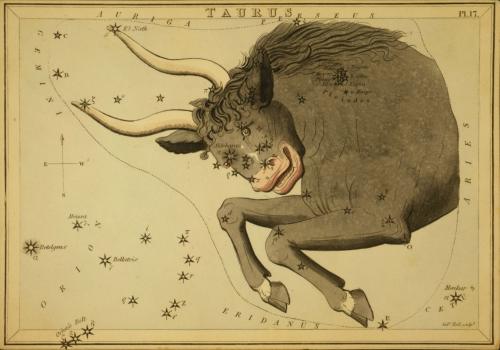On January 22, 23 and 24, 2021, the bright waxing gibbous moon shines in front of the constellation Taurus the Bull. With the moon in the way, it’ll be difficult to envision the starlit figure of the Bull on these nights. But, despite the moon’s glare, you might see this constellation’s two major signposts: the bright red star Aldebaran and the Pleiades star cluster, otherwise known as the Seven Sisters.
During the moon’s trek through Taurus, the moon passes to the south of the Pleiades and then to the north of Aldebaran. Notice that the Pleiades has the shape of a tiny dipper. Notice that Aldebaran has a reddish color. This bright star represents the Bull’s fiery red eye.
EarthSky lunar calendars are cool! Stock is getting low. Order now!


The fact is, each month for many years to come, the moon will pass to the south of the Pleiades and to the north of Aldebaran.
Yet, month by month, the moon will travel farther north in front of Taurus, until it goes so far north that it stages a series of 79 lunar occultations of Alcyone (the Pleiades’ brightest star) from September 5, 2023, until July 7, 2029.
What’s more, starting on September 7, 2023 (only two days after the initial occultation of Alcyone), the moon will present the first of a series of 49 monthly occultations of the star Elnath – aka Beta Tauri, or the second-brightest star in Taurus – from September 7, 2023, until April 11, 2027. Check out Elnath on the detailed chart of Taurus, below. Elnath is about half as bright as Aldebaran, Taurus’ one and only 1st-magnitude star.
Aldebaran marks the tip of a V-shaped pattern of stars – really, a star cluster – called the Hyades, representing the Bull’s face. Yet Aldebaran isn’t part of this star cluster. It’s a chance alignment, with the Hyades cluster at more than twice Aldebaran’s distance away. You’ll have an easier time seeing the V-shaped face of the Bull in a couple of weeks, when the moon has dropped out of the evening sky.
Just as Aldebaran depicts the Bull’s red eye, so the star Elnath marks the tip of Taurus’ northern horn and the star Zeta Tauri its southern horn. After the moon and Aldebaran first pop into view at nightfall, they’ll continue (along with the rest of the stars) to move westward throughout the night, as Earth spins under the sky. These two luminaries will set in the west in the wee morning hours.
Want to know when the moon sets in your part of the world? Visit Sunrise Sunset Calendars and remember to check the moonrise and moonset box.
Want to know in which constellation of the zodiac the moon resides? Visit Heavens-Above.

The moon and Aldebaran go westward across the sky tonight for the same reason that the sun goes westward during the day. The Earth rotates from west to east on its rotational axis. So, each day, as the Earth spins full circle beneath the heavens, the sun, moon, stars and planets all appear to go across the sky from east to west daily.
At the same time, the moon is actually traveling eastward in front of the constellation Taurus the Bull at the rate of about 1/2 degree (the moon’s angular diameter) per hour. Relative to the backdrop stars of the zodiac, the moon travels on the average of about 13 degrees per day.
If you watch the moon over the next several nights, you’ll see the waxing gibbous moon farther east relative to the backdrop stars than on the previous night, as shown on the feature sky chart at top. As it moves, the moon will be edging closer to full moon, which will fall on January 28, 2021.
Read more: Full Wolf Moon in late January 2021
Bottom line: On January 22, 23 and 24, 2021, the moon is sweeping through Taurus the Bull. It’ll go between the famous Pleiades star cluster and Taurus’ brightest star, Aldebaran.











